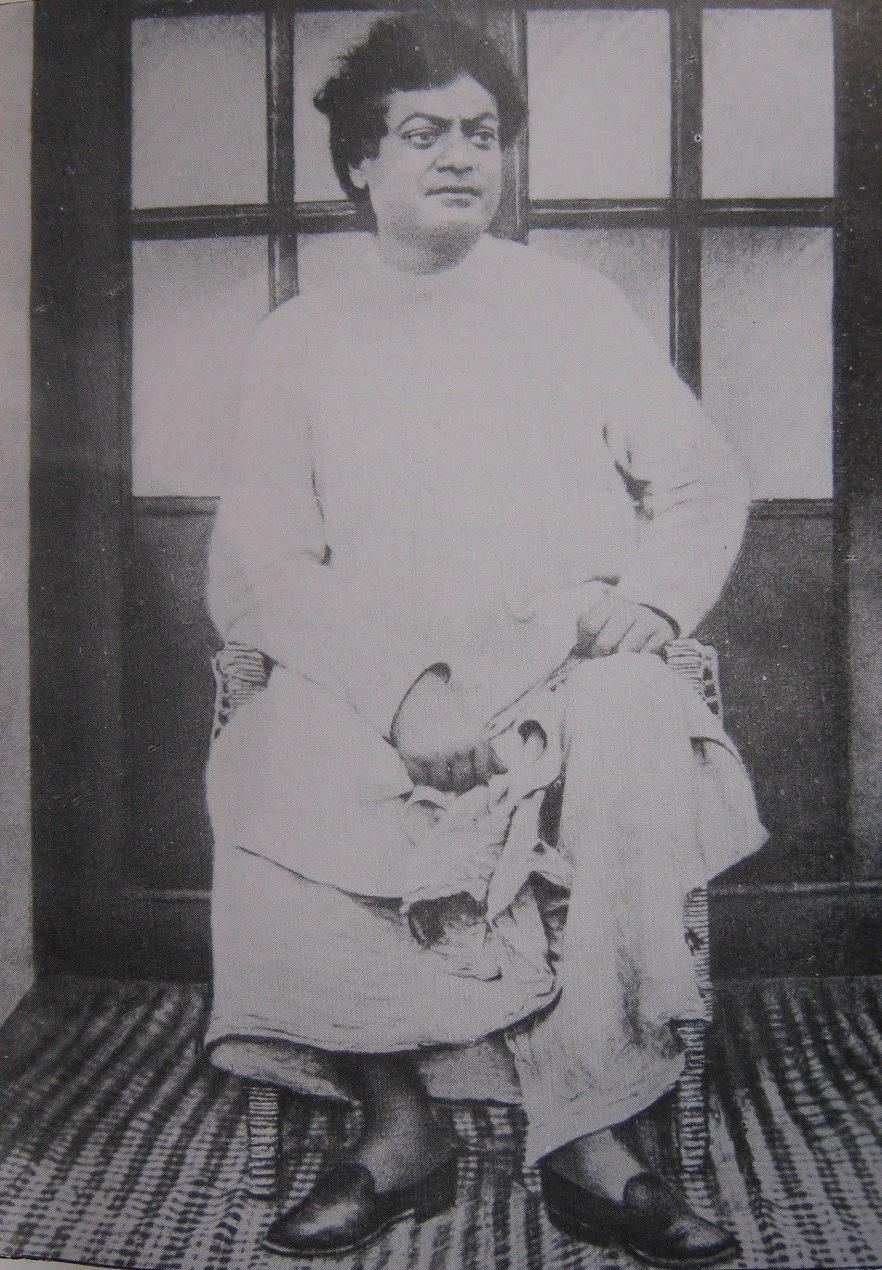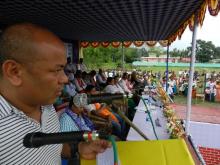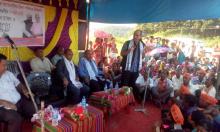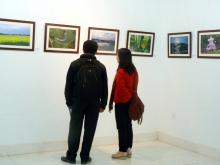Exactly 113 years ago, on 27th April 1901 Swami Vivekananda gave a historic speech that not only pierced his countrymen but also the then Chief Commissioner of undivided Assam, Sir Henry Cotton and other officers of the British establishment here at the Quinton Memorial Hall at Shillong later came to be known as the Ramakrishna Mission Vivekananda Cultural Centre (RKMVCC). Vivekananda’s visit to the northeastern region was not any coincidence but it was a preplanned one by the world renowned revered monk-philosopher, who has travelled worldwide spreading the wisdom of ancient Indian.
In April, 1901 Swami Vivekananda visited the then undivided Assam from Dhaka. In fact, in that year Swamiji planned to go for pilgrimage with his mother and other family members. Accordingly he started for East Bengal at the Dhaka followers’ invitation to improve his health condition and to take his mother for a pilgrimage to Langalbandh and Kamakhya. The trip started on 18th March, 1901 through waterways in a steamer to reach Dhaka. From Dhaka on 5th April he started for Kamakhya but his arrival date is not known exactly but it is contemplated from a piece which Swamiji wrote himself at the house of a Kamakhya panda (priest) dated 17th April, where he put up, that it could be the first half of that month. It reads:
“I have great pleasure in certifying the great amiability and helpfulness of the brothers Shivakanta and Lakshmikanta Pandas of Sri Kamakyapeetham. They are men who help most and are satisfied with the least. I can unhesitatingly recommend them to the Hindu public visiting this most holy shrine.”
In Kamakhya he stayed for three days and from there he proceeded towards Shillong. Prior to the Shillong visit he gave three speeches at Guwahati. There is not much documents except that of Padmanath Bhattacharya’s writings, who was a critic of Swamiji. Actually Swamiji’s visit to Guwahati and his lectures there is a culmination of what one gets from Bhattacharya’s reminiscences as his records only throws light to Swamiji’s Guwahati visit. After his darshan at Kamakhya he took rest in Guwahati for some days but his stay has become more or less a history. The main obstacle of Swamiji’s preaching of Vedanta philosophy was the then conservative society and Padmanath was one of the chief patron of this society. He was a professor at Cotton College, Guwahati. His book “Ramakrishanma-Vivekananda Prasanga” was written mainly to criticize Vivekananda. Following his departure from the house of the Kamakhya panda, he was put up by Padmanath in critical ill health in Guwahati. There is no detail about the house where he was accommodated. Padmanath writes, “In a verandah a fair complex person with saffron ochre and vest was sitting. His hairs were uncombed and his lips were blood-red chewing betel-nut.” Why Padmanath was a staunch critic of Vivekananda can be gauged from this incident.
After seeing Padmanath, Swamiji pinpointing blind orthodoxy commented, “That this scared thread on your body has been mortgaged from the Parsis”.
Padmanath: “How can it be because Ved Mantram was recited while installing the sacred thread and in that mantra the word ‘Yajno Pavita’ is clearly mentioned?”
Swamiji: “Please read that mantra.”
Padmanath: (chanted) “Yajno Pavita Paramam Pavitram...”
Swamiji: “See this mantra is interpolation. This mantra’s rhythm and its words are modern in nature”.
Padmanath: (in an excited mood) “I am perturbed. There is no difference between you and Dayanand Saraswati and in this condition there cannot be any debate.”
In Guwahati, Swamiji gave three speeches but there are not any written records of any of them. The topic of the first of those speeches is also not known. Commenting on that first day, Padmanath writes, “When I somehow managed to get a small space to stand inside the overcrowded hall, there was pin-drop silence. Since Swamiji was unwell he gave the speech while sitting. Swamiji repeatedly urged the members of the audience to propose any topic or issue on which we can speak and discuss. But there was none in the audience who could gather enough courage to propose anything. Observing their silence he said, “Where is that Bhattacharya”. To which a member of the audience, who has heard about the above debate between Swamiji and Bhattacharya, replied that he has gone to Basistha Ashram.”
The Laban house where Swami Vivekananda stayed in April, 1901
Having heard that Swamiji was enquiring about him, Bhattacharya himself said that he is present inside the hall amidst the audience and because of the crowd he was not in a position to reply. In this questioning, the pin drop silence that preceded the hall vanquished when an audience proposed Swamiji, “Please say something on casteism”. To start with he gave a tirade speech on untouchability. Padmanath later recalls that he heard and remembers two words from Swamiji’s mouth, “Cookery Religion” (hearth religion) and “Chooth Margo” (untouchable sect whose touching of anything is considered as unholy and unreligious). On the day of this very first speech, a renowned scholar of Assam and writer of “Prayog Koumudi” Dhireshwar Bhattacharya interacted with Swamiji in Sanskrit language. After that prior to his Shillong visit he delivered two more lectures. In these two lectures the topics for discussion were publicized beforehand. A senior Bengali advocate presided over in one of these penultimate lectures. Assam Valley Division Commissioner, AP Bahadur also presided in one of these lectures when Swamiji spoke on “Transmigration of the Soul”. However, the other topic of the remaining lecture is not known. Since the subject is not known Padmanath could faintly recall that Swamiji deliberated on an Upanishad verse “Dwa Suprna”. From this it can be perceived that the subject was from “Vedanta in Indian Life”. Despite being a hard critic, Padmanath said in his writings that his speeches were worth listening; his voice was sweet, audible pronunciation and he had an unmatchable capacity to use correct words at right places. Padmanath later recalls that on his first meeting with Swamiji, he could not realize that he is Vivekananda from his shabby appearances. On that speech day looking at the robes in his head, he could gauge that he is Vivekananda the one whom he saw in photo frames. “His way of giving speech while walking and roaming on the stage looked more like he was the hero of a drama. His bright large eyes and a smiling handsome face were also an attraction. After 20 years (at the time of writing this book), his face is still looming large on my eyes and his manly piercing voice in my ears. Was America mad about him for no reason? In this two day lectures many Britishers were also present and they wholeheartedly acknowledged by clapping him every now and then.” It is evident that despite being a critic, no love or respect was lost by Padmanath for Vivekananda.
From Guwahati, Swami Vivekananda sanctified the city of Shillong. During that time his health deteriorated considerably and in order to improve his physical condition he visited Shillong on an invitation of Sir Henry Cotton. He came from Guwahati to Shillong with his mother, sister, aunt, Gupta and Ramlal dada’s wife. They put up in the house of Rai Saheb Kailash Chandra Das at Laban. His granddaughter Dipanjali Mazumdar said that in 1901, Rai Saheb Kailash Chandra Das and Jyotindranath Basu fetched Swamiji and his family members from Guwahati in a horse drawn cart as KC Das and Jyotindranath walked alongside the cart. They put up at a roadside hut for a night on the way. Swamiji stayed for about 20/25 days in this Laban house. Looking at his ailing health, Cotton arranged for his treatment. Then Shillong had a sizeable population of educated Brahmo Bengalis who had great influence on the society.
Cotton was aware about world renowned Vivekananda and was highly impressed by his stature. Once he went to meet Vivekananda in the Laban house for a homely discussion when Cotton asked him, “After roaming all over Europe and America why have you come here and who is going to embrace you?” However, Swamiji’s reply to Cotton is not available for want of documents. But on another occasion Swamiji said, “In a monk’s life taking pilgrimages is their duty. And so he came to Shillong via Kamakhya. Moreover, in a place where there is a person like Henry Cotton that place itself becomes a pilgrimage. Cotton is a person who understands India’s problems very well and wants its betterment.” The Laban house where Swamiji stayed has gone on to become a major pilgrimage site for visitors and tourists alike, thereafter. The house was constructed with hay and at the anterior there was an open verandah. Later this house was developed into an Assam type cottage by covering the verandah. In 1943, KC Das sold this house to Nagendranath and Dhirendranath Chowdhury, two brothers from Sunamganj in Sylhet (Bangladesh). But today this structure is completely razed to the ground for want of care and attention. At present the relatives of Nagendranath are the caretaker of this property.
A public meeting was organized under the presidentship of Cotton at Quinton Memorial Hall where Swamiji gave a speech. According to Padmanath Bhattacharya, Swamiji delivered only one speech in front of a packed hall, where people even stood outside to hear him. While delivering the speech, Swamiji’s health further deteriorated and could not convey further. Regretfully this lecture was also not recorded. But a report of the lecture was recorded in May, 1901 edition of ‘U Khasi Mynta’, a Khasi monthly. The report which appeared in Khasi language was letter translated by Swami Gokulananda and was published in Vedanta Kesari, a monthly magazine of the Ramakrishna Order. The translated copy provided by a volunteer of Ramakrishna Mission, Shillong reads:
“… He began by saying that any religion without a sacred book cannot stand the test of time. As examples of this thesis, he cited the religions of the Romans, the Greeks and others. Though their religions were based on knowledge and discipline in the long run they could no survive, for they had no sacred books. But when people have their sacred books of their religion, even though they might go astray like the Jews, their religion or faith can never die. It is the same with the Hindus, he said. Even they are very much misguided by those manmade multifarious teachings. But so long as their Gospel, the Vedas remain, there is hope.
In his speech, Swami Vivekananda laid stress on the fact that religious ceremonies without deeds are worth nothing. A man who does something, who performs something, although he might commit crimes, is better than a man who does nothing or performs nothing, for the slothful and undutiful are not different from a tree or a bull. He quoted and recited stanzas from the Vedas in Sanskrit and then translated into English. He preached at length for the betterment of the fellow human beings. He divided the good deeds of human beings into three categories – first is to give alms, to help the physical body with food and clothing; the second is to give training and knowledge, like teaching in a human school; and the third is to show the human soul the way to God realization. He stressed this last category as the most important. For this, he said men like the Brahmins must be respected for they are preachers of the soul.
He exhorted men to enlighten his fellow beings and help them. Those who could afford to go to school should be provided with facilities to learn extensively but those who could not, should at least learn the alphabet. He has done a good thing and he must be praised and blessed. He concluded by saying, “Our work in India now is to open the eyes of the people.” From all his speeches and the stanzas that he quoted and recited from the Vedas, one can understand that he considers all human beings in the world as one. None is to be looked down as a low caste Hindu. He said that the Vedas exhort that we should preach to the people the truth. Probably, it is for this reason he had travelled throughout the world and preached.”
After staying for about 20-25 days in Shillong instead of improving, Swamiji’s health deteriorated further. At last he returned to Belur Math in the morning of 12th May, 1901.







Comments
Thank you for this well
Thank you very much reader.
Very nice article.
Pages
Add new comment